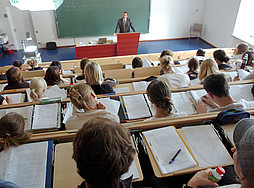- The teaching load should primarily be fulfilled by offering the courses provided for in the examination regulations or curriculum.
- In addition, the Dean can recognize the following achievements:
- Supervision for final theses
- Creation and support of multimedia offerings
- Above-average demands on the admission of prospective students in selection procedures and entrance examinations as well as other aptitude tests
- A university degree in the area of continuing education
- In addition, courses that are not provided for in the examination regulations or curricula can also be credited. The prerequisite for this is that these courses are listed in the course catalog.
Notes
Professors who have been assigned exclusively or predominantly non-teaching duties by the university are not subject to any teaching load. The university must take appropriate measures to compensate for the reduction in the range of courses offered. Compensation can also be provided by a representative of the same subject who belongs to a different faculty. There is no compensation obligation if the tasks outside of teaching are financed from third-party funds or if the legislator stipulates this in the state budget.
If a lecturer is unable to fulfill their teaching loads in their area of responsibility due to a surplus in teaching, the teaching load is reduced accordingly. The faculty must notify the President of the reduction.
If a subject’s teaching needs change, in individual cases the faculty may set down the scope of teaching activities. Here it must be taken into consideration that the teaching obligations are fulfilled on average in three successive academic years. Teaching activity during the semester should not be less than half of the respective teaching load.
The teaching load can also be fulfilled if
- a lecturer fulfills their teaching loads on average over three consecutive academic years or
- lecturers in a teaching unit can balance out their teaching loads within the respective semester; professors and junior professors can balance out their teaching loads only among themselves.
There must be no work-related reasons to the contrary; the overall range of courses in a subject specified in the examination regulations or curricula must also be guaranteed. The teaching activity of the individual lecturer in a semester should not be less than half of the respective teaching load.
The following teaching loads apply at the University of Hohenheim (assuming full-time employment):
| Professors | 9 teaching units per week (LVS) |
| Junior professors | 4 LVS |
| Academic staff (habilitation candidates) | 4 LVS 6 LVS (after positive qualification) |
| Research associates | Individually defined in the task description Possibilities: 5-12 LVS (mainly active in research) 13-19 LVS (mainly active in teaching) 20-25 LVS (only active in teaching) |
The different types of courses are weighted differently when counting towards the teaching load.
| Teaching hours | Crediting |
|---|---|
| Lecture |
|
| Seminar |
|
| Exercise course |
|
| Colloquium |
|
| Internship |
|
| Excursion |
|
| All remaining courses |
|
| Supervision work for theses |
|
| Creation and support of multimedia offerings |
|
| Above-average demands on the admission of prospective students in selection procedures and entrance examinations, as well as other aptitude tests |
|
| Teaching rendered in the area of continuing education |
|
Notes
For example, the teaching work performed by a staff member for a course for which a professor is responsible can be credited against the teaching loads of this staff member only. If this staff member does not have a teaching load (e.g. doctoral candidate, postdoc), the LVS cannot be credited at all.
Insofar as the type of course does not require constant supervision by an instructor, the course is counted towards the teaching load by a factor of 0.3.
In this case, the LVS are proportionately counted according to the amount of the respective teaching.
Example: If two instructors work on one course, and one instructor takes on 60% and other 40% of the teaching, exactly these percentages are counted toward the teaching load.
Each instructor gets full credit for the LVS, a maximum of three times.
Example: If three instructors work on a course, each instructor may count one LVS toward their teaching load; if four instructors work on a course, each instructor may only count 0.75 LVS toward their teaching obligations.
For Humboldt reloaded courses, special regulations apply.
If the university has not drawn up a job description for an academic staff member containing the specific scope of the teaching load, the teaching load is 25 LVS.
For permanent and fixed-time part-time employees, the teaching load is reduced in proportion to the scope of employment.
The teaching load may be reduced for lecturers who take on additional tasks in academic self-administration:
- Member of the President’s Office: Reduction of up to 6 LVS
- Leave of absence allowance for members of the Dean's Office of a faculty, including the Dean: Total reduction of up to 14 LVS
- Dean of Studies: Reduction of up to 6 LVS
- Vice Dean: Reduction of up to 4 LVS
- Further Vice Deans: Reduction of up to 2 LVS each
- Deans of Studies who are not members of the Dean's Office: Reduction of up to 4 LVS each
In total, the reductions in a faculty must not exceed 20 LVS.
- The President decides on the scope of the leave of absence allowance available to the individual faculty and on the individual distribution at the suggestion of the Dean's Office.
- If a lecturer performs several of the functions stated above, a reduction can be granted for one function only.
The university is obliged to prove to the state of Baden-Württemberg that its staff are completing their teaching load. The teaching load is recorded at
- Faculty A: Information on fulfilling the teaching load
- Faculty N: Fulfilling the individual teaching load
- Faculty W: Form available in the Dean's Office

